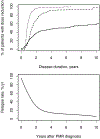Comparable Rates of Glucocorticoid-Associated Adverse Events in Patients With Polymyalgia Rheumatica and Comorbidities in the General Population
- PMID: 28704600
- PMCID: PMC6475501
- DOI: 10.1002/acr.23320
Comparable Rates of Glucocorticoid-Associated Adverse Events in Patients With Polymyalgia Rheumatica and Comorbidities in the General Population
Abstract
Objective: To investigate the use of glucocorticoids (GCs) and related adverse events (AEs) in a long-term, geographically defined cohort of patients with polymyalgia rheumatica (PMR).
Methods: Using a population-based inception cohort, details of GC therapy were abstracted from medical records of all patients diagnosed with PMR in 2000-2014. Age- and sex-matched comparators without PMR were identified from the same underlying population. Cumulative and daily dosage of GC, rate of disease relapse, occurrence of GC-related AEs, and rate of GC discontinuation were analyzed.
Results: The study included 359 patients with PMR and 359 comparators. The median time to taper below 5 mg/day for 6 months was 1.44 years (95% confidence interval [95% CI] 1.36-1.62), while the median time to permanent discontinuation was 5.95 years (95% CI 3.37-8.88). The mean ± SD cumulative dose of GC at 2 and 5 years was 4.0 ± 3.5 grams and 6.3 ± 9.8 grams, respectively. The mean ± SD daily dose of GC at 2 and 5 years was 6.1 ± 7.6 mg/day and 7.2 ± 9.5 mg/day, respectively. There were no differences in rates of AEs between patients with PMR and comparators for diabetes mellitus, hypertension, hyperlipidemia, or hip, vertebral, or Colles fractures (P > 0.2 for all). Cataracts were more common in patients with PMR than comparators (hazard ratio 1.72 [95% CI 1.23-2.41]).
Conclusion: Relapse rates in PMR are highest in the early stages of therapy. Despite often protracted therapy, with the exception of cataracts, the rates of studied morbidities linked to GC are not more common in PMR than comparators.
© 2017, American College of Rheumatology.
Figures
References
-
- Matteson EL, Buttgereit F, Dejaco C, Dasgupta B. Glucocorticoids for management of polymyalgia rheumatica and giant cell arteritis. Rheum Dis Clin North Am 2016;42:75–90. - PubMed
-
- Harris E, Tiganescu A, Tubeuf S, Mackie SL. The prediction and monitoring of toxicity associated with long-term systemic glucocorticoid therapy. Curr Rheumatol Rep 2015;17:513. - PubMed
-
- Unwin B, Williams CM, Gilliland W. Polymyalgia rheumatica and giant cell arteritis. Am Fam Physician 2006;74:1547–54. - PubMed
-
- Dasgupta B, Cimmino MA, Kremers HM, Schmidt WA, Schirmer M, Salvarani C, et al. 2012 provisional classification criteria for polymyalgia rheumatica: a European League Against Rheumatism/American College of Rheumatology collaborative initiative. Arthritis Rheum 2012;64:943–54. - PubMed
-
- Binard A, de Bandt M, Berthelot JM, Saraux A. Performance of the polymyalgia rheumatica activity score for diagnosing disease flares. Arthritis Rheum 2008;59:263–9. - PubMed
Publication types
MeSH terms
Substances
Grants and funding
LinkOut - more resources
Full Text Sources
Other Literature Sources
Medical
Miscellaneous


